Road Trip 2012: Vermont: Into the Depths of Danby Quarry (Part 2 of 2)
Peter J. Marcucci
Special Correspondent
 In regards to the scope of this next subject, mere words cannot possibly render the images, sounds and feelings of the experience I had.
In regards to the scope of this next subject, mere words cannot possibly render the images, sounds and feelings of the experience I had.
However, I can offer a glimpse of a huge undertaking much larger than anything I have ever witnessed. It is a moment’s look at a century’s worth of work. The scale and magnitude of the Danby Quarry precludes, and by far eclipses, this writer’s ability to describe in detail a cold, dark hole in the earth. With that being said, I am both humbled and privileged at every sentence.
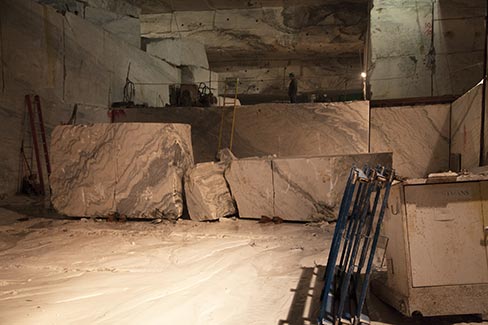 What can I say? After hearing all the chatter about the Danby Quarry, I couldn’t resist the opportunity to swing by and have a look-see for myself; so it was up the mountain road to begin my next adventure. The drive past the many acres of color-coded blocks was the easy part, only just a primer for what lay ahead. As I think back, forbidding was the first thought that came to mind driving closer to the giant hole in the side of the mountain.
What can I say? After hearing all the chatter about the Danby Quarry, I couldn’t resist the opportunity to swing by and have a look-see for myself; so it was up the mountain road to begin my next adventure. The drive past the many acres of color-coded blocks was the easy part, only just a primer for what lay ahead. As I think back, forbidding was the first thought that came to mind driving closer to the giant hole in the side of the mountain.
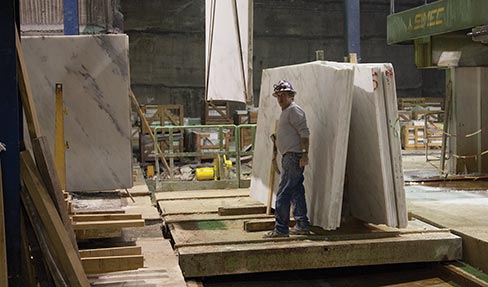 Parked and out of the car, camera in hand and not a person in sight, I slowly walked to the entryway of the hole and stopped. After reading the warning signs, I inched a little closer to push the entry button. As I did, forbidding turned into intimidation while being coldly struck by a severe drop in temperature. It was like Alaska was waiting for me on the other side of this cold, black opening. As I continued closer, now in a naturally air-conditioned environment, it was with great angst that I pushed the button. What? No buzzer, no light, no nothin’. Hmm, now what?
Parked and out of the car, camera in hand and not a person in sight, I slowly walked to the entryway of the hole and stopped. After reading the warning signs, I inched a little closer to push the entry button. As I did, forbidding turned into intimidation while being coldly struck by a severe drop in temperature. It was like Alaska was waiting for me on the other side of this cold, black opening. As I continued closer, now in a naturally air-conditioned environment, it was with great angst that I pushed the button. What? No buzzer, no light, no nothin’. Hmm, now what?
Standing there, just me and my apprehension patiently waiting for someone from somewhere to just come and give me some information so I could get the heck out of there, I began hearing unfamiliar sounds and feeling vibrations from the mountain. Getting a bit insecure (okay, a lot insecure), I turned and began walking away—quickly, turning back occasionally with only swift glances of indefinite hope.
Now paused with noises and vibrations still increasing, I again inquisitively sized-up the now distant hole and thought, do I really want to be here?
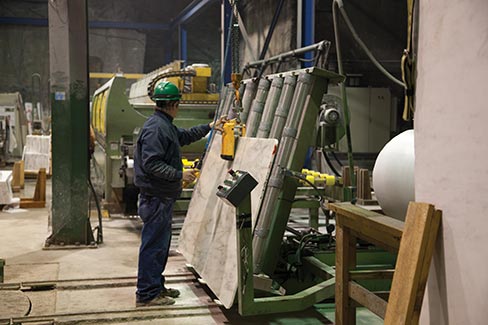 Then, to my relief, the evidence surfaced out of the darkness in the form of a marble block being carried topside in the jaws of a front-end loader, giving my insecurity a temporary reprieve.
Then, to my relief, the evidence surfaced out of the darkness in the form of a marble block being carried topside in the jaws of a front-end loader, giving my insecurity a temporary reprieve.
Again at the opening while patiently waiting and pensively wondering, should I go—or should I stay?, I heard a distant door shut and then a raspy, but friendly, “Hello—come on down!”
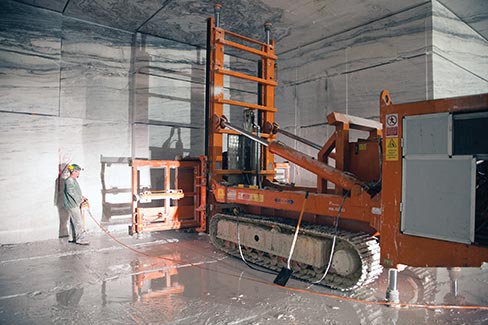 After meeting and shaking hands with Mike Blair, the quarry supervisor, I immediately apologized for my unexpected arrival. Mike just turned to me and calmly said, “Get in! You’re just along for the ride!” and with that, we were off into the murky depths of the Danby Quarry, for the ride of my life.
After meeting and shaking hands with Mike Blair, the quarry supervisor, I immediately apologized for my unexpected arrival. Mike just turned to me and calmly said, “Get in! You’re just along for the ride!” and with that, we were off into the murky depths of the Danby Quarry, for the ride of my life.
Yee-ha—and thank goodness for four-wheel drive pickup trucks and seatbelts as we went down grade angles of heart-stopping proportions. Looking left and right with great enthusiasm, I could swear I saw Mike out of the corner of my eye, laughing as I my foot repeatedly searched for that “imaginary brake.”
As we continued down, down and more down, we then swung a quick left and eventually came to a grinding halt at rock bottom, over one mile deep according to Mike. Whoa! I thought, this was more fun than Universal Studios!
Mike then pointed to a large machine in operation that sat closely against a solid marble wall while braced to the ceiling and floor of the cavern. He explained that it was one of seven diamond chainsaws in the company’s arsenal of cutting equipment, and just one of the ways that blocks were cut here.
He then pointed out the different color striations of materials that were being cut from top to bottom. “Picture the mountain like a multi-layer cake and you’ll understand how each layer is a different color throughout the quarry,” he said, adding that this is the largest underground marble quarry in the world.
“Why underground?” I asked. He explained that the Danby Quarry has been in operation since 1902, and because of Vermont’s extreme winters, working underground in an average temperature of 46-48 degrees with no snow or rain is a big plus. “We cut an average of 9 blocks per week, and we’re able to do it consistently, year after year with no interruptions from the weather. That’s the first reason,” he said.
As I stood fascinated by this underground world, I began firing away more questions, and Mike did his best to answer. “Quarrying is an imperfect business and a lot of responsibility, but all of us here do our best every day.
“An average year of cutting yields about 500,000 cubic feet of seven different colors. When the blocks are cut and set aside, I then do the grading. For reasons of color and strength, some blocks are more suited for slabs than tile. After the blocks are cut into tiles or slabs, they are shipped all over the world.”
He went on to explain that two shifts are required to supply the never ending demand for Danby marble, and that the company’s 28 employees, many cross-trained, usually work 40 hours per week to fulfill that demand.
We were then back into the truck to check production in another area, this time with no more “imaginary brake” needed and no sweaty palms. Stopping a for a second time, I got out to watch a diamond saw begin its horizontal plunge cut 10 feet into a huge wall of Montclair Danby.
A few minutes later, Mike dropped me off for the big treat—the “icing on the cake:” a fully-equipped underground production area.
Awestruck by the many cranes, bridge saws, and CNCs, I walked everywhere and watched everything, including a Simec gang saw that had just finished cutting a block into slabs. As cranes flew slabs overhead in all directions, other slabs traveling on an automated production line were headed to a Simec line polisher for finishing.
Amazed at what I had just witnessed, I made my way back to the truck only to find that Mike, the good soul he was, had been waiting there the whole time. He asked, “Have you seen enough?” I answered yes.
We then went up to the surface, and as I shut the door I thought to myself, the hole in the mountain that I didn’t want to go into, I now didn’t want to leave. We traveled up, and up—and up, the light at the end of the tunnel getting bigger—and within moments we were topside.
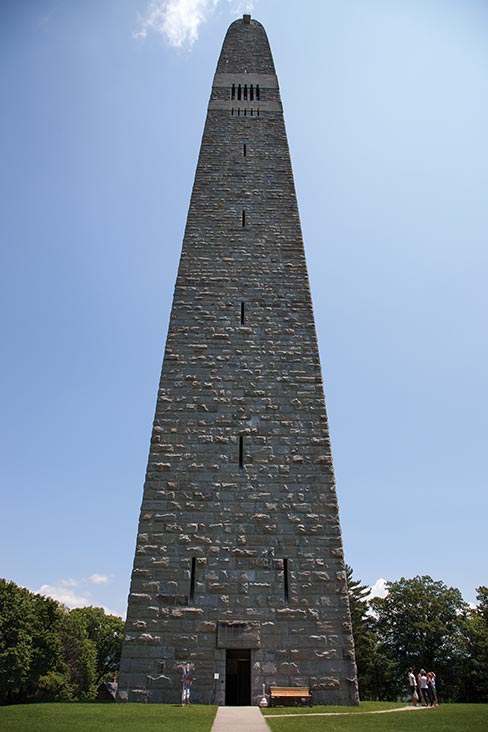 Mike, still enjoying his role as tour guide, brought me to the entrance of one of two new tunnels under development. When we stopped, he pointed to a mountain that had part its side removed, exposing rough, jagged layers of multi-colored rock.
Mike, still enjoying his role as tour guide, brought me to the entrance of one of two new tunnels under development. When we stopped, he pointed to a mountain that had part its side removed, exposing rough, jagged layers of multi-colored rock.
“This newly opened deposit has taken us five years to get into,” he said. “The first 800 feet of surface crust here is waste, and we need to go deep into where the usable material is,” he continued, waving his hand. “If we started cutting from the surface, we’d have to remove all that top crust and dispose of it. That’s the second reason we do our cutting from underground.”
He went onto explain that this new area would produce high-quality marble for well over a hundred years and that he is getting this shaft ready for his future replacement.
Moving again, we drove past the smorgasbord of blocks waiting to be processed. Mike explained that for safety reasons, he sometimes needs to take extra care in areas that he suspects might shift or sink. “I have two ways of dealing with these types of problems. One way is to core drill ten-foot deep holes into the supporting walls of these areas. We then insert a vial of red dye into each of those holes, and if there is any shifting or movement, the vial will break and release the dye.
“The other is to secure cables from end to end into these questionable areas with a gauge in-between. Any movement in the wall or ceiling can then be measured by reading the gauge.” Pulling up to my car, Mike said, “The safety of my guys and this operation is always on my mind.”
Opening my door, I offered a handshake and thanked him for taking the time to show me something I would never forget. I drove off and realized that inside this raspy-voiced, stone-tough guy, was hidden a heart of gold, just like the treasure inside the mountain.
The Bennington Battle Monument
On the final leg of my journey while going southbound along Route 7, standing tall amid a backdrop of mountains was the Bennington Battle Monument. After exiting, I purposely took the long way, driving the dirt back roads.
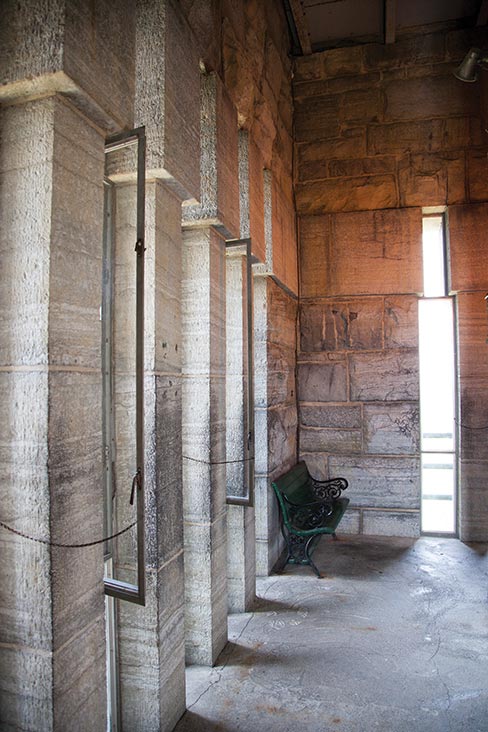 Mountains, after all, are a work-of-art in progress, and I now wanted to be in them and not just driving by them. Motoring past the many horse and dairy farms, I couldn’t help waving back to the friendly farmers driving their full wagons of first-cut hay to the barn.
Mountains, after all, are a work-of-art in progress, and I now wanted to be in them and not just driving by them. Motoring past the many horse and dairy farms, I couldn’t help waving back to the friendly farmers driving their full wagons of first-cut hay to the barn.
Now, back on the highway and turning on to Monument Circle, I slowed, approaching the edifice I had so vividly seen from miles away.
Now on foot, standing next to its well-grounded base, I looked straight up. It’s times like these that a person reflects on how small one is in comparison to a structure of this magnitude. After coming to grips with this, it was up the elevator of the tallest structure in Vermont.
Once into the observation area, I was treated to majestic views of Vermont, New York, and Massachusetts through the five slotted windows on each side. I also got a queasy feeling looking straight down. I should really know better by now, one would think. After snapping a few pictures and making a pact with myself to revisit in the fall, it was back down the elevator to ground level for more pictures and details.
It turns out that the Battle of Bennington was actually fought just over the border in New York near the Walloomsac River on August 16, 1777. In a collective effort led by General John Stark, Colonel Seth Warner and other great leaders, approximately 2,000 volunteers from Vermont, New Hampshire, and Massachusetts banded together to take the war right up the noses of the British troops led by General John Burgoyne.
In a two-steps forward–one-step back battle, the mostly untrained Yankee militias put one big hurtin’ on the British, turning the hunters into the hunted. The British had been trounced, trodden and lay debased. Those who stood, did so demoralized and eventually surrendered two months later in Stillwater, New York.
To commemorate this pivotal point of the Revolutionary War, and forever honor our men, construction of the monument began in 1887 and finished in 1891. Built using rough-faced Sandy Hill dolomite, a blue-gray magnesian limestone quarried in nearby Hudson Falls, New York, this 306 foot tall monolithic structure proudly sits on a 37 foot base, and is capped by a bronze and gilt, ten-point star that serves as a lightening rod. Well worth the stop, the Bennington Battle Monument is a must-see, especially in the fall. It is a symbol of what Americans can accomplish when we put our minds and backs into getting things done.
Peter J. Marcucci has over 25 years of fabrication experience in the stone industry. Send any comments to pjmgsxr@aol.com.